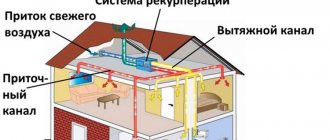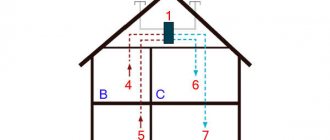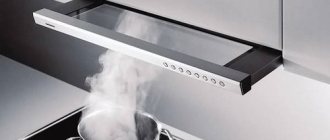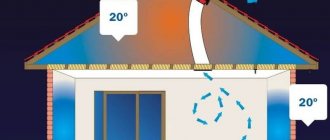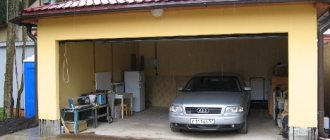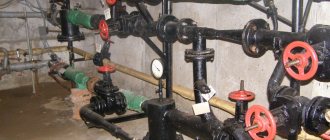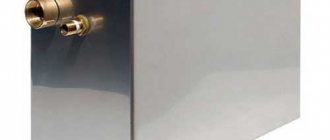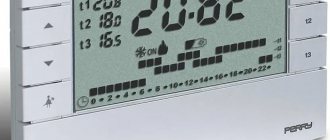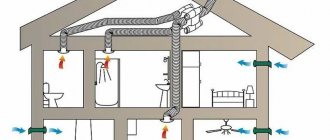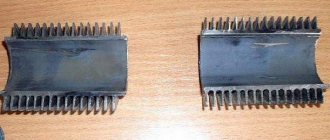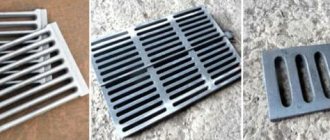Supply ventilation for an apartment is an effective way of air exchange. In this material we will tell you how to competently organize a microclimate system in a residential area. Ineffective ventilation systems are a problem in many apartment buildings. Lack of draft and clogged air ducts cannot cope with the outflow of exhaust air. Drafts and heat loss through ventilation reduce the overall level of household comfort and increase heating costs. Plastic windows make the situation worse. Sealed double-glazed windows and thermal insulation of the building interfere with the natural flow of fresh air into our apartments. How to solve the issue of effective air exchange? Which supply ventilation to choose for an apartment so that the system functions properly - we will tell you in more detail below.
Air exchange is the key to a healthy microclimate
A high-quality ventilation system in an apartment building should create a pleasant microclimate and maintain good air quality. A properly designed and installed installation does not cause drafts and removes carbon dioxide, water vapor, odors and tobacco smoke from the room. The air exchange control option is very important, which controls the supply and outflow as needed. This helps avoid damage caused by excessive humidity in the apartment. An important feature is noise reduction and reduction in heating costs.
Conclusions and useful video on the topic
This video clearly demonstrates the design and operating principle of supply ventilation, as well as its difference from natural ventilation of rooms:
Here you can see a review of the Eco-Fresh air handling unit:
Supply ventilation is a great way to provide your home with fresh air and create a favorable microclimate in it. All the efforts and costs of creating such a system will be fully repaid, since the health of all residents of the house depends on proper ventilation.
Share with readers your experience in improving the efficiency of supply ventilation. Please leave comments on the article and ask questions that interest you. The feedback form is located below.
How to make fresh ventilation in an apartment?
The typical construction of apartment buildings was carried out according to Soviet standards, which provided for exhaust vents in the bathroom and toilet. The kitchen hood was installed at the request of the apartment owner. The task of supply ventilation was assigned to vents and cracks in windows and doors. In a number of apartments you can find a cylindrical supply valve in the wall, which was plugged in winter due to drafts and cold. The issue of effective air exchange in our homes is still acute. How to make fresh ventilation in an apartment to create a comfortable microclimate? There are several ways:
- Manual or automatic ventilation. Organizing regular ventilation manually is problematic. You can use micro-ventilation - leave the window open 2-3 mm or install a servo drive on the window sash. The mechanism automatically opens the sash at set intervals. The devices are equipped with a set of sensors and close the window in case of high humidity or strong wind.
- Window or wall valve. Devices for windows are cheaper and easier to install. Optimal for small spaces. Wall inlet valves require drilling into the wall, are equipped with a coarse filter and are well suited for spacious rooms.
The methods listed above increase the regular flow of fresh air into the room, but have a number of disadvantages. They work on the principle of natural ventilation - based on temperature differences. Effective in winter, not effective in summer. They cool the room down during the cold season and increase heating costs. They do not filter the air or perform basic cleaning.
Forced ventilation devices cope well with the above problems:
- ventilators - an improved wall valve with a fan. Performance depends on the power of the electric motor;
- breathers - monoblock, compact devices with a multi-stage filtration system, heating elements, digital control and sensors;
- Air conditioners with fresh air supply do more than just cool or heat. The units are equipped with a chamber for mixing street air masses, which, after filtration, enter the room.
Supply ventilation for an apartment combined with air conditioning is a universal and effective solution.
Installation stages
The use of this type of ventilation is relevant in any room - from the bedroom to the kitchen. The number of valves can be selected in this way:
- 1 valve under each window.
- 1 valve for every 15-20 “squares” of area.
To install the ventilation valve you will need the following set of tools:
- Pencil (marker, pen).
- Hammer.
- Crown for concrete (diameter – 60 mm).
- Drill for concrete (diameter – 40 mm).
- Drill for concrete (diameter – 6 mm).
- Industrial vacuum cleaner (if not, use a broom and dustpan).
- Polyethylene (or rags) - to cover the work area.
- Thick and durable plastic garbage bag.
The product is installed above the battery so that the outlet “looks” at its center. In this case, the distance from the case (or rather, from the outlet) to the radiator must be at least 15 cm.
Drilling a hole for the air duct of the Domvent valve
Now let's look at the process step by step:
- Marking is carried out: the housing is applied to the wall in the selected location.
- Mark the center of the hole for the pipe and the holes for the fasteners.
- Using a crown with a diameter of 60 mm, the wall is drilled to a depth of 7-10 cm. In order not to litter the floor in the room, you should place a bag under the hole (or lay down film/rags).
- Using a drill with a diameter of 40 mm, the wall is drilled through.
- A plastic tube is inserted into the hole made. From the outside it should be flush with the surface of the wall, from the inside it should protrude by 7-10 mm. If necessary, the pipe should be cut to the required size.
- A heat insulator is placed on the end of the tube closest to the room. It should protrude from the hole by about 10 mm, no more. If necessary, excess is cut off.
- From the outside (from the street) a grate is glued to the tube (this will have to be done while leaning out of the window).
- Using a drill with a diameter of 6 mm, holes for fasteners are drilled.
- Fastener plugs are inserted into the holes.
- The valve body is pressed against the wall and fixed with self-tapping screws.
- An anti-mosquito net and seals are installed in the housing.
- The housing closes.
The procedure itself, with the participation of two people and the presence of the above-mentioned tool, will take about an hour on average. The cost of installing a Domvent ventilation valve by hired specialists will cost approximately 2,000 rubles.
Installation stages (video)
Care and cleaning
Over time, the use of the product leads to the fact that the seal located inside the housing gradually becomes dirty. It is recommended to clean it approximately once a year. The warm season is best suited for this, since the use of a ventilation valve is primarily relevant in cold weather.
To clean the sound absorber of the Domvent ventilation valve, you need to remove the housing cover, take out the seal and simply shake it several times to get rid of dust. Alternatively, you can do this with a vacuum cleaner (which is much more effective).
If there is too much dirt, you can wash it with a polyf under low-flowing water. In this case, the seal must be dried before installation. After cleaning, the sound absorber is installed back and covered with the housing cover.
Disassembled Domvent valve body
In addition to getting rid of dust, in winter you should pay attention to the condition of the outer grille - in severe frosts it can freeze. To solve the problem, the valve damper must be completely closed until the ice has completely melted.
Reviews about the model
It’s easy to find reviews about this model - many people have already installed it in private houses, apartments, and non-residential premises (offices, workshops, and so on).
Alexey V., 30 years old, Omsk:
About 3 years ago, supply valves were installed in our office so that noise (we are located in an area with constant construction) would not distract people from work. In winter, of course, you have to close it - despite the fact that the valve is located near the battery - the air still comes in cold.
But in the summer it is an irreplaceable thing. There is no need to open the windows, and the air conditioner is also turned on less often.
Dmitry A., 41 years old, Krasnodar:
In our country now, probably, all new buildings are immediately equipped with inlets. Last year we were choosing an apartment, probably looking at 15 options - and almost every new building had valves. The one we chose in the end turned out to be a Domvent: one in each room.
The model is not bad for its price - it has inflow adjustment and insulation (although it is more likely for show - such insulation is of little use, especially in colder latitudes). Well, it doesn’t let in much air - one valve is definitely not enough for the room.
Classification and types of supply ventilation for apartments
Ventilation systems for apartments differ in design, principle of operation and methods of organizing air exchange in the premises. Main classification criteria:
- forces causing air flow: natural, mechanical;
- operating hours: constant, periodic;
- method of organizing air exchange: general, local;
- air flow direction: supply, exhaust, supply and exhaust;
- differential air pressure: positive pressure ventilation, negative pressure ventilation;
- air treatment range: ventilation with cooling, ventilation with humidification;
- transport speed in supply channels: ventilation with low, medium and high air speed;
- Availability of air ducts: ducted, ductless.
Let's talk in more detail about the main varieties.
Natural ventilation
The operating principle is based on the different densities of street and indoor air and the force of gravity that moves air masses. Operating efficiency depends on the temperature difference between inside and outside the building. The larger it is, the better. This type of ventilation is most effective in winter and ineffective in summer. In new buildings with sealed double-glazed windows, natural ventilation does not work well even in winter and does not provide the required volume of air.
What is the difference between natural and forced ventilation in an apartment?
Natural ventilation works based on the laws of physics. Dense cold air entering the room displaces less dense indoor air. The supply air system is the ventilation system that is responsible for supplying air to the building. The principle of its operation can be either natural or mechanical. A servo drive on a window sash is the simplest example of supply ventilation operating on a natural principle. A breather with a built-in fan is a mechanical supply principle. Therefore this is an incorrect comparison.
Hybrid ventilation
The main disadvantage of natural ventilation is fluctuations in the draft force in the ventilation ducts and too weak or excessive ventilation of the premises. This problem is solved by hybrid ventilation - a type of natural ventilation with mechanical support in the form of a cap on the chimney. This solution significantly improves the air exchange of the room during the off-season and winter.
Mechanical ventilation
In this case, air flow is provided by fans. This allows you to fully control the intensity of air exchange in any conditions, clean, regulate temperature and humidity. Equipment performance is usually adjusted depending on external factors. The basic advantage of this solution is the ability to control the speed of exhaust and supply air.
With recovery
A mechanical air handling unit can be supplemented with a recuperator. Its task is to extract heat from the air removed from the room and heat the fresh air. This technology allows you to recover up to half of lost heat and reduce heating costs. Mechanical ventilation removes smog and other pollutants from the air entering your home. Provides complete independence from weather conditions. This means we don't have to open windows or install diffusers to provide airflow.
Physical basis of ventilation
The movement of air flows is based on the simplest physical processes. The gas-air mass is processed and transported thanks to existing convection processes. To use this natural process, heat and heating sources are placed in the lowest areas, and supply elements, on the contrary, are as close as possible to the ceiling.
In its general meaning, the term “convection” represents the redistribution of thermal energy between heated and cold gas flows. Convection processes can occur naturally or forcefully.
In a closed space, the overall temperature is determined by the degree of heating of the air. The value is not constant throughout the entire space, it varies with height. The phenomenon is caused by a non-uniform concentration of molecules at constant pressure inside the room. At a higher temperature, the concentration of gas particles is lower, which means its mass is lower. Therefore, there is a concept that heated air is “lighter” and cold air is “heavier”. This fact explains the design of ventilation systems: exhaust units are located at the top, and supply units are located at the bottom.
Air movement usually occurs from bottom to top Source sovet-ingenera.com
A well-designed exhaust ventilation system in combination with natural convection processes allows you to maintain the set level of temperature and humidity indoors.
Scheme of supply ventilation in the apartment
Cold air enters the room through cracks, windows, ductless supply systems or air ducts using fans. Less dense indoor air rises up and is discharged through ventilation grilles located near the ceiling in the kitchen and bathrooms. The removed air causes an influx of fresh air, which enters the bedroom, living room and other rooms. During installation, it is important to ensure the unhindered movement of clean air to the ventilation grilles. Implementation option: ventilation slots in the doors.
Differences between the models in the line
The OXY supply ventilation line is represented by three models:
- OXY 1 has a basic set of functions: it provides a constant flow of fresh air, is equipped with a dust filter, and operates in passive mode (without a fan). The device is completely silent, productivity is up to 60 m3/hour.
- OXY 2 is equipped with a fan and can operate in both passive and active modes (up to 150 m3/hour). It has a dust filter, a noise level of no more than 25 dB, and can be operated at temperatures from -40°C to +50°C.
- OXY 3 is equipped with a fan and a dust filter; when operating in active mode, it consumes no more than 18 W per hour. Equipped with a heater with a power of 980 W: heating the incoming air flow eliminates the possibility of drafts.
What is the difference between natural and forced ventilation in an apartment?
Supply ventilation only works to supply fresh air. Supply and exhaust - for supply and outflow. In residential premises, the exhaust system can function separately.
Example: duct fans in bathrooms and an extractor hood in the kitchen. The inflow is carried out through windows, diffusers, window or wall valves.
Mechanical system with heat recovery
An alternative to natural ventilation is a mechanical heat recovery system. The premises are equipped with air ducts for supplying fresh air and ventilation ducts for removing exhaust air. The most important element of this system is the recuperator, which “takes” the heat from the exhaust air and transfers it to the supply air. This eliminates large heat losses typical of traditional ventilation and restores up to 90% of heat. The unit is equipped with a filtration system and pre-cleanses the air from dirt, dust, allergens, and toxins. Mechanical ventilation allows you to precisely control the intensity of air exchange.
Forced system without recuperation
In forced ventilation without recovery, heat loss is higher, but the issue of heating the supply air can be solved using duct heaters. Additionally, the incoming air is cleaned. The quality of filtration depends on the class of the filter. It consists of several independent fans (in the kitchen, bathroom and other rooms), each of which is controlled by its own sensor that measures air humidity.
Advantages and disadvantages
The advantages of supply and exhaust ventilation are:
- High degree of purification.
- Supply and exhaust ventilation systems are easy to operate. They can easily replace spent elements.
- This ventilation system has a modular design.
- To expand functionality, extension modules are available. For example, additional electronic control modules, improved filters, timers, and noise absorbers are available.
- High efficiency in cases where it is necessary to ventilate large rooms.
- The work occurs automatically. There is no need to monitor the system for this.
- By installing a recuperator you can make work more efficient.
principle of operation of supply ventilation
This ventilation system has the following disadvantages:
- The calculation of power and other system parameters should be carried out by specialists.
- Regular expenses are required to maintain performance.
The use of such systems is possible for large and small rooms. However, it is more advisable to use supply and exhaust ventilation where higher operating power is required.
Ventilation in the apartment wall: supply valve
A supply valve in the wall is a technically simple, but very important element of a mechanical ventilation system. Responsible for supplying air to the room, mounted in the wall. These devices are often installed as an alternative to ventilation grilles. More modern models have an adjustment mechanism. Available in plastic and metal cases. The former are cheaper, resistant to moisture, and not subject to corrosion, but lose strength when exposed to UV rays. Metal appliances are made from galvanized steel sheet and powder coated to prevent rust. They cost more than plastic ones, but last longer.
Components and parameters of the ventilation unit
Let us examine in more detail the components of ventilation equipment, without which it will not be possible to create an optimal microclimate in the room. And let’s look at their main characteristics and important parameters of the installation itself.
No. 1 - device for heating air
As already mentioned, the air coming from outside must be heated in winter. For an apartment, a heater with a power of 3-5 kW is usually sufficient.
For a house or cottage you will have to perform a number of special calculations. This takes into account the outside air temperature, as well as the power of the installation itself.
In this case, it is important to correlate the load on the power supply network of an apartment or house with the actual state of the network. If the load on the electrical network is excessive, it can lead to a serious accident.
Technical specifications of the electrical installation as well as the power of the heater are necessarily indicated in the accompanying documents and in the operating instructions. It is important to find out all the necessary parameters before purchasing equipment
In such cases, some home owners prefer to choose an air handling unit with a less powerful heater.
This solution is fraught with the following problems: when severe cold occurs, the air will not have time to warm up to the required temperature, and a cold stream will flow into the rooms.
It is not difficult to prevent this phenomenon - you just need to reduce the number of fan revolutions.
Air masses will flow more slowly, but will still have time to warm up. Performing such adjustment manually is extremely inconvenient.
If you have to buy a control unit with a low-power heater, you should make sure that the device is equipped with automatic control of the fan speed depending on the outside air temperature.
No. 2 - acoustic power of equipment
When figuring out what ducted supply ventilation is, you should take into account information that determines the noise effect from the operation of the device.
There are three indicators of PU acoustic power:
- at the entrance;
- at the exit;
- on the body.
The “input” noise characterizes the sound effect that the installation will produce at the beginning of the system. It usually does not affect the comfort of the home too much. It is much more important to pay attention to the noise “at the output”, i.e. in places where ventilation grilles are installed.
If this figure is too high, during installation you will have to include an additional element in the system - a noise absorber. To obtain a sufficient effect, the length of this element must be at least 90 cm.
The supply unit of the ventilation or air conditioning system is installed outside the building, in this case the noise from the operation of the fan and heater will not disturb the residents of the house
Noise “on the body” indicates the acoustic effect in the immediate vicinity of the air handling unit, which is installed and connected to the system and noise absorption devices. This indicator is not very important if the control panel is installed outside the building.
But if this is not possible, and the device is planned to be placed directly in the building, preference should be given to a device with a minimum acoustic power value “on the body”.
In addition to acoustic pressure, which is denoted in technical documentation as LwA, manufacturers use the concept of sound pressure level (denoted as LpA ).
These two concepts should not be confused, especially when comparing the characteristics of different models. It is better to focus on LwA, since data on LpA are usually somewhat lower.
No. 3 - automatic control systems
Automation is simply necessary for the normal operation of the ventilation unit. Even the simplest options are equipped with devices for automatically regulating the temperature of the discharge air and the fan speed.
The status of the device and current settings are reflected on the display with the control panel.
Automatic control of the supply ventilation system significantly improves its operation and saves resources. Some models are equipped with a remote control
More “advanced” automation allows you to set settings for different periods of time. For example, you can reduce the temperature and fan speed at night, when everyone is sleeping and the need for fresh air is not so high.
Separately, you can set the mode for daytime on weekdays, when no one is at home.
For convenient control of the air handling unit, it is recommended to choose a device with the following characteristics:
- the number of fan speeds is at least five;
- availability of real time clock;
- saving and launching settings in the event of a power outage;
- monitoring the level of filter contamination;
- possibility of remote control, for example, using a smartphone;
- message about the presence and nature of malfunctions.
Indication of the filter status is not required, but is highly desirable. In the absence of this option, cleaning or changing the filtration elements is performed after a certain time recommended by the manufacturer.
But operating conditions vary, and as a result, contamination may occur earlier or later than the specified period. Monitoring the condition of the filters will allow you to change them in time or extend their service life.
Ways to increase the efficiency of “inflow”
An effective way to supply air to rooms is to install diffusers. You can purchase new windows with factory diffusers or choose models for wall installation. It is possible to install the device in already installed windows, but this will void the manufacturer's warranty. Typically, one device is sufficient for a room, unless its area exceeds 20 m² (in which case two may be required). The air flow intensity can be adjusted manually or automatically depending on the model. Many devices are equipped with humidity sensors that respond to pressure changes and temperature changes.
Differences between a ductless “inlet” and a ducted one
For urban housing this option is optimal. It takes into account all the features of living space in a multi-storey building, including low ceiling heights and limited area.
There are many reasons to buy supply ventilation for an apartment, and one of them is a favorable combination of price and functionality. Among other advantages of such equipment, buyers note:
- High performance. The air supply rate of “active” supply ventilation in a room is on average 100-150 sq.m3/hour (20-30 sq.m3 per hour is required per person);
- Ease of management. Some models are controlled by regulators on the body. Another option is a remote control or via Wi-Fi through a special application on a smartphone;
- Possibility of air filtration. For modern cities, this ventilation function is more than relevant. The device may include one or more filters (types of retained contaminants, odors and cleaning depth depend on the model and cost of the device);
- Compact device, easy installation. No pipes under the ceiling, no expenses for installing false walls that hide communications. There are also no annual duct cleaning costs. The device has small dimensions and is mounted directly on the wall. The installation process takes no more than an hour, without dust and dirt. Installation can be carried out even for final repairs.
Budget options for restoring air exchange
Ventilation efficiency can be increased using simple and inexpensive devices.
Features of different types of window valves
There are two types of valves:
- with manual regulation;
- with automatic regulation.
Manual adjustment consists of installing a special damper in one of several possible positions. The effectiveness of such diffusers largely depends on the user's actions. Automatic regulation is more productive. These models respond to changes in the pressure difference between inside and outside the room and change the position of the damper.
Example: strong gusts of wind. In this case, the pressure difference increases. The damper in the diffuser closes, preventing excessive inflow of outside air.
Wall model: device and installation
Models intended for installation in the wall are inferior to window valves in popularity, but are also quite in demand. They are a cylindrical body with decorative panels and a filtration system. The devices are placed in an external wall at a height of at least 2 m from the floor or above a heating radiator. Cool air entering the room through the air intakes is warmed by warm air that accumulates under the ceiling. As standard, they have thermal insulation that prevents the formation of condensation on the valve, and a coarse filter. Some manufacturers offer diffusers with an electric heater to preheat the air entering the room.
Options for organizing inflow
We will explain the importance of fresh air ventilation with an example. Imagine a sealed container of water being pumped out by a pump. Since the vacated volume is not filled with air, the pressure in the tank drops. At a certain point, the pump will not have enough power to overcome the vacuum and pump out further - the impeller will begin to mix the water in place.
Key moment. When indoor air exchange, a similar principle applies - natural or forced exhaust will not be able to effectively remove polluted air if replacement with an influx is not provided.
Without normal inflow, a more powerful hood creates a reverse draft effect (overturning) in a ventilation duct of a smaller cross-section.
After installing sealed plastic windows and filling the supply gap previously located under the window sill, the entry of air masses from outside is excluded. Consequences: a fan or ventilation duct of a larger cross-section (usually in the kitchen) upsets the draft in a smaller shaft (toilet), from where an unpleasant odor enters the apartment. The living room, bedroom and other rooms are left without ventilation at all.
There are several ways to make complete supply and exhaust ventilation of a private home:
- folk method - trimming window seals;
- buy an air conditioner with the function of supplying outside air;
- install an adjustable air valve into the plastic window;
- make a hole in the wall and install a local air supply device.
Advice. The performance of a natural home hood can be checked as follows: remove the ventilation grilles in the kitchen and bathroom, attach 2-3 strips of paper over the first opening, seal the second one tightly with A4 sheet and tape. If the strips are drawn into the channel, it means that air is entering the apartment - the draft is working.
Diagram of a one-story house with possible options for air supply devices
Let's consider the pros and cons of each of the listed methods. The task is to offer you the correct and relatively inexpensive way to organize the influx.
The simplest free method
The essence of the method is to use existing drainage holes in the window profile, designed to drain condensate outside. Two hidden holes where water goes are located on the inside of the frame, the outlets are on the outside of the profile and are closed with plugs, as shown in the photo.
One condition: the method will not work if there is poor traction in the vertical channel. Start by checking the hood and cleaning the ventilation shaft.
The idea of home craftsmen allows you to quickly organize supply ventilation with your own hands without financial costs:
- Open the window sash and remove the mosquito net.
- Using a screwdriver, remove both plastic plugs from the outer drain holes.
- Using a knife, carefully cut out a section of the rubber seal on the upper end of the frame no more than 5 cm long. Close the window.
The operation of this ventilation is based on the following scheme: under the influence of the draft of the ventilation duct, outside air is sucked through the drainage hole, passes inside the profile and enters the gap between the sash and the frame. Having risen to the upper part, the air flow enters the room through the opening in the seal.
In winter, heating of the cold inflow begins in the window structure and ends at the outlet, when the air is mixed with the ascending convective flow coming from the heating radiator. A supply gap is made in a similar way in a plastic balcony door, but with additional trimming of the outer rubber, as shown in the video:
The advantage of this option is zero cost and a real opportunity to ventilate the apartment with the window closed. There are many more disadvantages:
- the air flow cannot be adjusted; strong wind will blow through the gap;
- in summer, unfriendly insects, such as wasps, can settle in open drainage;
- during the warm period, when natural draft decreases due to a small temperature difference, small holes will not allow the required amount of air to pass through.
The last disadvantage: removing part of the rubber seal is only possible on opening sashes. Drilling into blind windows is not an option. Therefore, the method cannot be called correct and cannot be recommended to all homeowners.
Split systems with ventilation function
In addition to heating/cooling modes, household air conditioners from a number of manufacturers are capable of supplying outside air to the room and even operating as an exhaust hood (alternately with the supply air). Why this option is convenient:
- renewal of the air environment in the room occurs forcibly, regardless of the traction force in the shaft;
- the air drawn in by the fan is processed - filtered and heated or cooled;
- flow intensity is adjustable;
- the volume of inflow does not depend on gusts of wind and other weather conditions.
Operating diagram of the indoor unit of the air conditioner
Reference. The air mixture is sucked in by a separate fan located in the internal block of the split system. An additional pipe is laid through the outer wall - an air duct up to 1 m long.
The main problem with the implementation of such air exchange is the high price of the equipment. Buy an air conditioner for each room for 500-600 USD. That is, for the sake of fresh ventilation - it is inappropriate; there are cheaper options. But if you plan to install a split system for cooling, you should think about choosing a unit with air supply and recirculation.
We formed the negative aspects of using an air conditioner as an air supply unit based on reviews from online store customers and forum visitors:
- The inflow is carried out only when the unit is turned on; the rest of the time the outer channel is covered with a damper.
- A separate fan, responsible for supplying fresh air mixture, is constantly noisy.
- Due to rapid contamination, you will have to clean the filters more often.
- On some models, ventilation and air conditioning modes are incompatible. Air supply and heating are switched on separately.
Note. A detailed guide will help you correctly install a split system in a private house or apartment.
Installing a supply valve in a window
The so-called window ventilator is an oblong plastic cover equipped with an adjustable flap. There are 2 types of valves:
- Mounted on fixed windows. A through inlet slot is milled into the profile, a protective canopy is screwed on the outside, and a cover with a flow regulator is screwed on the inside.
- Products for opening sashes. They are installed on the inside of the frame, part of the sealing rubber is replaced with a special material. There is no need to mill the window.
Valve operating diagrams: for opening (left) and closed valves (right)
Reference. Valves allow you to organize the operation of supply and exhaust systems with natural impulses and are designed for all types of translucent structures - PVC, aluminum and wood. Popular brands are Vents, Air-Box and Aereco, price – up to 10 USD. e.
It is advisable to use supply window devices in rooms with good exhaust, otherwise the air supply will be scanty. The declared performance of the valves is about 30 m³/h, which is enough for one person, but not enough for normal ventilation of living rooms.
For the boiler room and bathroom, where the standards provide for more intense air exchange, you will need 3-4 similar products; it is easier to embed the flow grille into the door. Another nuance: the real performance of devices is very different from the declared one.
Calculating the inflow is easy - find out the dimensions of the inlet slot and determine the amount of air passing through it, using our instructions. The result will be less than the promised 30 m³/h (let’s say: no more than 25 cubic meters at a speed of 1 m/s). For 3 family members you will need 4 valves in each room, absurd.
How to install a supply valve on a leaf:
- Place the body of the product against the upper end of the open frame at the mounting location.
- Focusing on the edges of the lid, cut off the standard seal; for the Air-Box, the length of the removed section will be 35 cm. A similar piece of rubber must be cut on the main frame, opposite the sash.
- Insert 3 plastic dowels - clamps - into the groove of the window profile, aligning them with the mounting holes on the cover. Remove the protective tape from the body and screw the valve with self-tapping screws.
- Instead of the cut seal, glue the elements from the ventilation device kit.
It is more difficult to install a valve in a solid frame - you need to carefully cut a narrow opening in the profile. If you don’t want to contact craftsmen and pay money, make the gap yourself - apply precise markings and drill holes. The visor and inner cover are installed without problems. Brief instructions for installing the product on the sash are presented in the video:
In general, window ventilators are suitable for a small apartment. But in the rooms of a country cottage with high ceilings, the declared performance is not enough. The second negative point: often the PVC window frame is half covered by the upper slope, leaving no room for the valve. Then another technical solution called...
Wall ventilation device
A passive ventilation valve mounted inside a wall consists of the following elements:
- supply pipe with a diameter of 60-150 mm (size depends on the model and performance of the device);
- the outer end of the pipe is covered with a mosquito net and a ventilation grille;
- an adjustment valve is built in at the other end;
- From the side of the room, the pipe is connected to the housing, where an air filter (cleaning class G3) and a heat-insulating gasket are placed.
Note. To prevent condensation from forming inside the channel, a layer of insulation is laid between the wall and the pipe.
As in the previous case, the inflow through the valve is ensured by the vacuum created by exhaust shafts or fans. The products are capable of transmitting 35-60 m³/h of air into the room, depending on the user settings. When you turn on a local hood with a mechanical drive, for example, a kitchen one, the inflow flow will also increase to 70-90 m³/h.
In devices of various brands, there are 2 types of performance regulators - petal and diaphragm, the second will be cheaper. If necessary, any damper can be completely closed. The price of products starts from 15 USD. e., popular, Domovent, Helios and others.
How to install the valve:
- Determine the location of the ventilation element. The recommendation is as follows: it is better to place low-capacity devices with a Ø60 mm pipe between the window sill and the heating radiator. Place valves with a diameter of more than 10 cm next to the window opening at a height of 2 m from the floor.
- Make a through hole in the wall using a hammer drill and a set of drills of suitable length. In a frame or wooden house, use core drills. If the room borders on a balcony, it is better to drill from the outside.
- Cut the pipe to the thickness of the fence, wrap it with Penofol insulation and insert it tightly into the hole. Fill the remaining cracks with foam.
- From the inside, attach the valve body to the wall, connecting it to the pipe. Place a ventilation grill outside.
Advice. Make the hole as round as possible, guided by the outer diameter of the channel wrapped in insulation. The products are equipped with telescopic sliding pipes; there is no need to cut them. For installation details, watch the video:
The scope of application of passive inflow devices is much wider than ventilation in an apartment or country cottage. The valves can provide air exchange in other ancillary buildings - a bathhouse, a boiler room, a garage with a basement.
There are only two disadvantages: lack of heating of cold air and manual adjustment during operation. In summer the damper opens fully, in winter it is set to minimum. Advantages:
- the valve is suitable for most ordinary users in terms of price and performance;
- incoming air is cleaned by a filter;
- the device does not freeze or become covered with condensation, frost appears on the head in frost below minus 35 °C;
- does not consume electricity, operating costs are minimal.
The heads of the ventilation elements look quite aesthetically pleasing
Ductless forced ventilation
Ductless forced ventilation is a budget-friendly and effective way to organize air exchange in small rooms.
Advanced Wall Valve
The extended configuration model has automatic control, pressure, humidity and temperature sensors. Maintain a constant amount of supply air. They are equipped with deep cleaning filters that remove suspended dust, smog, and pollen. They have a built-in heating device and a laconic decorative panel.
Breezer - compact ventilation unit with climate control
Breezers are “smart” and functional devices with a system for protecting the air from dust, smog, viruses and allergens. They are mounted into the wall and have a multi-stage cleaning system, including HEPA filters. Effectively cope with air supply to a room from 40 to 80 m². Controlled from the front panel and remote control. They have a built-in fan, ionizer and air heater.
Air conditioners with fresh air supply
Air conditioners with fresh air supply replace or effectively supplement the supply ventilation for the apartment. Universal and multifunctional equipment. A standard air conditioner works only with indoor air. This split system has a chamber for mixing fresh air and a pipeline that provides supply.
Supply and exhaust ventilation with air conditioning
Sometimes this option is called central air conditioning, since the air is distributed not in one room, but throughout the entire apartment, where the ventilation ducts are laid. The advantage of this system is that this option is cheaper than equipping each room with a separate air conditioner. Outdoor unit installation options may be limited. One external unit with a heat exchanger of a powerful air conditioner does the job better than several weak ones.
Advice: choose an air conditioner with the ability to heat the air and built-in heating of the crankcase of the outdoor unit - then for winter operation you will not have to install a separate heater. Which air conditioner is better to choose for an apartment? In a special article we will consider the rating of popular models, selection criteria and assessments.
Central air conditioning lacks the characteristic indoor unit with a drum fan and curtains. Instead, the freon line from the compressor goes to the duct distributor. Air is supplied to the distributor through supply ducts, and is exhausted, already cooled, to those places that are beneficial to the owners - usually to the kitchen and living rooms. Another system of exhaust air collection pipelines concentrates it and removes it outside. The distributor is not equipped with fans. They are supplied separately in the quantity required by the project. Unlike the usual split system, central air conditioning combined with ventilation is a construction kit, from the components of which you can create a solution for any living space.
Internal distributor
Supply duct multi-systems
Supply duct multi-systems are multifunctional installations that allow you to effectively restore heat loss and control the operation of the device depending on the microclimate parameters in each room.
The principle of operation of the complex with recovery
Supply and exhaust ventilation with recovery for an apartment are energy-efficient installations that require significant investment, but pay for themselves during operation.
A recuperator is a device that allows you to reduce heat losses during ventilation of premises. The principle of operation of the recuperator: heats the fresh air entering the house with the heat of the exhaust air. The transfer of thermal energy occurs in the heat exchanger. The supply and exhaust flows do not mix.
VAV system - ventilation according to needs
The abbreviation VAV stands for Variable Air Volume. How is this implemented in practice? Special dampers are installed on the supply and exhaust network. Each mechanism is equipped with a drive, electronic and measuring system that responds to pressure drop across the device. Sensors monitor humidity, carbon dioxide concentration and temperature in each room. When changing the specified parameters, the VAV system increases or decreases the air volume in the room. This principle allows flexible control of equipment operation.
Essential elements
Supply ventilation includes the following elements:
- Ducts are pipes that carry air from outside. They are made of stainless steel, plastic or aluminum alloys. They can be hard or flexible. The specific type of duct depends on the system used.
- The heating device is designed to heat the air entering the room from the street. It is used only in the cold season. Water or electric heating is used. The first option is suitable for large rooms, the second is used in small rooms.
- When heating the air, the heat from the air inside the room can be used. In order to do this, a recuperator is used.
- The fan is used to create a flow of air from the street into the room.
- The incoming air may contain dust, dirt, insects, dust, and fur. Filters are used to prevent contaminants from entering the premises. They can be of different types depending on what they protect against. High-quality filters protect against all types of contaminants, but there are also those that prevent only insects from entering the room.
- Some ventilation systems make noise when operating. Parts made of special materials are used for noise absorption
- To make ventilation convenient to manage, an automatic control system is used. Various sensors and regulators are used for operation.
elements of supply ventilation
Additionally, the use of humidifiers, dehumidifiers and air disinfectants may be provided.
Standards for apartment ventilation systems
When designing a ventilation system for residential premises, the provisions of SNiP 41-01-2003 and SP 60.13330.2016 should be taken into account. These standards define the minimum amount of air (in m³) that must be removed within an hour. Building regulations contain requirements that apply to every installation, regardless of how it operates. Equally valid for devices operating on natural and mechanical principles.
Minimum volumes of required air exchange:
- 70 m³/hour - kitchen with gas stove;
- 50 m³/hour - kitchen with electric stove;
- 50 m³/hour – bathroom;
- 30 m³/h - separate sanitary unit;
- 30 m³/h - living rooms separated from the kitchen or bathroom by more than two doors or located on another floor;
- 15 m³/hour - utility rooms without windows (pantry, dressing room).
Experts from the engineering company Qwent recommend installing exhaust fans in kitchens and bathrooms that can remove up to 120 m³ of polluted air per hour. At night, you can reduce the ventilation intensity, but not more than 40% of the required norm.
What formulas are used in calculations
The main parameter that needs to be calculated in any system is how much air should be changed within an hour.
For residential apartments, the value is determined according to the living area: V=2xSxH, where S is the area of the living room, 2 is the coefficient of air mass exchange rate per 1 hour, H is the height of the room.
For work premises, the calculation is made based on the number of personnel: V=Nx35, where N is the number of people simultaneously present in the room.
When calculating the power of a ventilation station, the formula is used: P=ΔT * V * Сv/1000, where V is the volume of air mass consumed per hour, Сv is the heat capacity of the air mass, ΔT is the temperature difference of the air mass at the ends of the pipeline. The accepted value of heat capacity is 0.336 W * h/m³ * °C.
Another important indicator is the cross-sectional area of the duct, measured in square centimeters. There are 2 types of sections: square and round. By calculating the cross-sectional area, it is possible to determine the width and height of a rectangular pipe or the diameter of a round one.
Which supply ventilation to choose for an apartment
The choice of supply ventilation system equipment depends on several factors:
- Size and volume of the room.
- Complexity of planning.
- The number of people living in the apartment.
- Equipment that generates heat (office equipment, heating devices).
If you need to organize the inflow locally, in one small room, you can install a window/wall valve or buy a breather. If uniform, regular air exchange in all rooms with control of the volume of incoming air and effective cleaning is important, a supply and exhaust unit will be required.
Equipment selection
After you have created a project for a future supply-type ventilation system and have decided on its type, you need to start selecting equipment for ventilation in the apartment. It is necessary to pay increased attention to this stage, since the quality of the future structure will depend on this. When choosing a particular fan model, you must take into account the following parameters:
- number of fan revolutions;
- maximum fan power;
- installation performance level;
- the maximum working area that the selected fan can handle, etc.
Installation location and features
We’ll tell you in more detail how to install fresh air ventilation in an apartment. Diffusers and supply grilles should be installed as far as possible from the front door. It is most effective to use the air supply in the upper zone of the room. This arrangement of supply and exhaust elements ensures proper air circulation. If rooms have different ceiling heights (for example, sloping attics), it is recommended to install fresh air ventilation devices at the highest point. In rooms with a ceiling height of more than 3 meters, devices should be located in the area where people are present. Incorrect placement may result in insufficient air flow in ventilated areas. Installing ventilation is a complex process, so we recommend turning to professionals.
How to organize fresh ventilation in an apartment?
A good way to organize additional fresh air flow is to install diffusers. Small ventilation devices are mounted in a window or wall. Devices with hygrocontrol react to excess humidity and close the window when the indicator is exceeded.
Cleaning ventilation grilles can improve draft by up to 60%. As a result, air freely enters the ventilation duct. Hybrid ventilation can also be used. Chimney caps increase negative pressure in the ductwork. The devices use wind energy, stabilize the draft in the chimney and work like rotating hoods. Disadvantage: Only effective when the wind is blowing. You can check the supply ventilation in the apartment, for example, by calling a specialist with professional equipment.
The problem of ineffective natural ventilation is eliminated by using electric exhaust fans. They are mounted at the entrance to the ventilation duct instead of the ventilation grille or in the air duct itself. The efficiency of the fan is greatly influenced by the length and smoothness of the air duct, which determines the resistance to air flow. In rooms without ductwork, fans are mounted in a wall or window. The valve design prevents insects from entering the room and drafts.
How does supply ventilation work in an apartment?
Fresh air enters the room through the air duct system, open windows, and leaky connections. If the ventilation system in an apartment operates on the gravitational principle, the movement of air masses occurs due to temperature differences and gravity. In mechanically driven installations, the flow speed is set by an electrically driven fan.
Why is supply ventilation needed in an apartment?
A controlled flow of fresh air is required for all residential premises. This requirement is enshrined in SNiP and the set of construction rules. Irregular ventilation is not able to ensure high-quality circulation of air masses. Result: headaches, poor health, risk of colds, weakened immunity, inability to concentrate, low productivity.
What problems does the inflow solve?
Supply ventilation provides a regular flow of fresh air into the room. Modern installations are equipped with a multi-stage filtration system. It is possible to install duct coolers or heaters. Mechanical ventilation with recovery is responsible for circulating and heating fresh air with waste heat. The recirculation process takes place in the heat exchanger. The system is optimal for cold climates with a temperature difference of 15°C between the street and the room.
Video description
More about the calculation of ventilation in the video:
Ssection = V * 2.8/w, where Ssection is the cross-sectional area, V is the volume of air mass (m³/hour), w is the air flow speed inside the highway (m/sec) (average from 2 to 3), 2.8 – dimensional matching coefficient.
For installation, it is necessary to calculate how many diffusers (intake and outlet openings) and their parameters are required. The dimensions of the nozzles are calculated based on the cross-sectional area of the main pipeline, multiplied by 1.5 or 2. To calculate the number of diffusers, use the formula: N=V/(2820 * W * d2), where V is the volume of air mass consumed per hour, W is speed of movement of the air mass, D – diameter of the round diffuser.
For rectangular diffusers, the formula is transformed as follows: N=π * V/(2820 * W * 4 * A * B), π is the number pi, A and B are the section parameters.
Useful program
The TURKOV company has developed a program for calculating the necessary parameters and selecting suitable equipment.
In any case, calculations of ventilation systems should be carried out by professionals - if something is forgotten or not taken into account, then the cost of the mistake is the need to redo the calculations and work.
A full calculation of supply ventilation is done using specific software Source ventisam.ru
